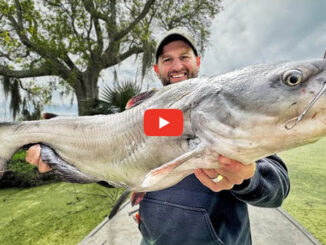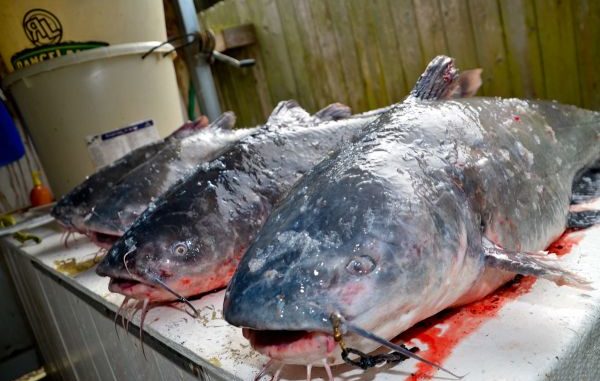
Skinning small catfish is a snap for most freshwater fishermen. After a few well-placed knife cuts, the skin is deftly snatched off with a pair of skinning pliers, and then the flesh is filleted from the backbone.
A few catfishermen don’t take the time to skin their fish first, but rather fillet them as any other fish is cleaned.
But big catfish — those over 10 pounds —demand different tactics.
And cleaning really big catfish — those over 25 pounds — is like butchering a hog. The skin is thick and tough; rib-cage bones are big and defy a sharp knife.
Worst of all, there is no convenient way to hold their bulky, slimy bodies to provide working leverage. Commercial skinning houses used to suspend big catfish from hooks, and skinners used every muscle in their bodies to pull the hide downward, off the carcasses.
Not Derek Logan.
“I don’t skin fish,” he stated flatly. “It’s nasty — a commercial deal. This is a family thing. They get more yield when they skin them, yeah. But this is for my family and friends.
“I clean catfish like I’m going to eat every piece. There ain’t no junk here.”
Logan’s method produced beautiful chunks of boneless, snow-white meat. All the red flesh was removed and discarded, a a process he said is critical to producing fish without a strong, fishy flavor.
The steps
1) Remove the catfish from the ice and hose them with fresh water to remove slime and ice particles.
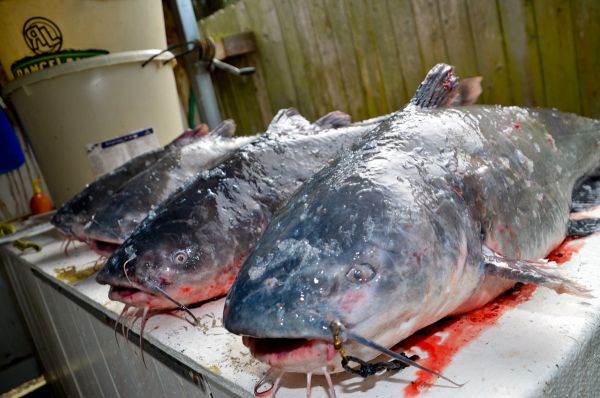 2) Make a deep, vertical cut down to the rib cage immediately behind the dorsal fin. Extend the cut, staying near the backbone, rearwards for the length of the fish.
2) Make a deep, vertical cut down to the rib cage immediately behind the dorsal fin. Extend the cut, staying near the backbone, rearwards for the length of the fish.
 3) Make a second cut downward on the side of the fish, from the front of the first cut down to the rib cage.
3) Make a second cut downward on the side of the fish, from the front of the first cut down to the rib cage.
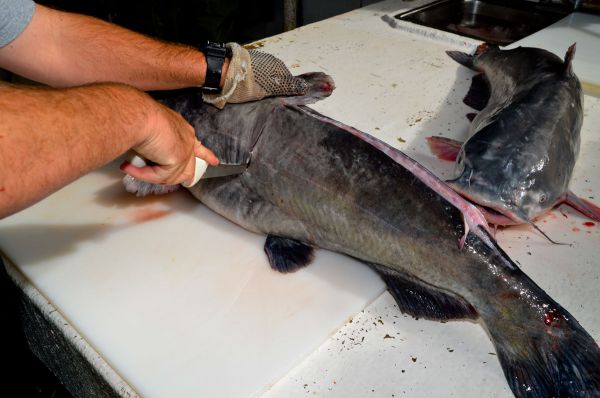 4) Cut the fillet from the backbone with short, precision knife cuts down to the rib cage.
4) Cut the fillet from the backbone with short, precision knife cuts down to the rib cage.
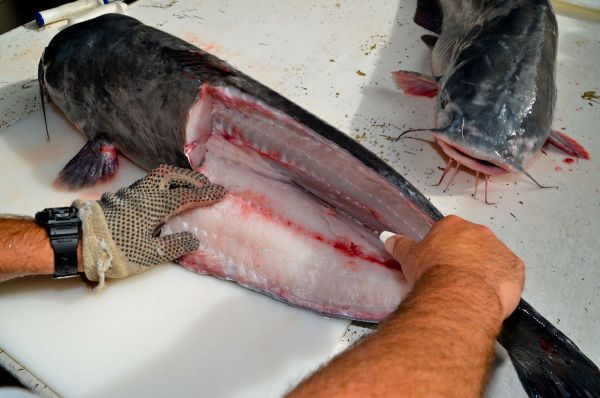 5) Free the fillet from the rib cage with short knife strokes. Do not cut through the large rib bones. Then cut through the skin attaching the lower part of the fillet to the body. Do not cut through the skin at the base of the tail.
5) Free the fillet from the rib cage with short knife strokes. Do not cut through the large rib bones. Then cut through the skin attaching the lower part of the fillet to the body. Do not cut through the skin at the base of the tail.
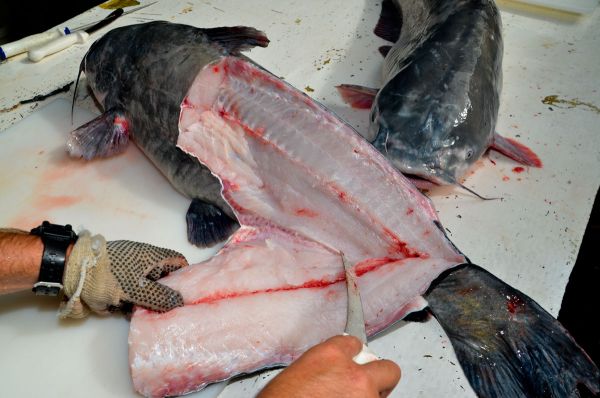 6) Flip the fillet skin side down, and insert the knife between the flesh of the fillet and the skin. Controlling the blade so it makes shallow slices, cut the fillet free from the skin. Cutting shallowly allows most of the red meat, with its objectionable taste, to remain on the skin rather than come off with the fillet.
6) Flip the fillet skin side down, and insert the knife between the flesh of the fillet and the skin. Controlling the blade so it makes shallow slices, cut the fillet free from the skin. Cutting shallowly allows most of the red meat, with its objectionable taste, to remain on the skin rather than come off with the fillet.
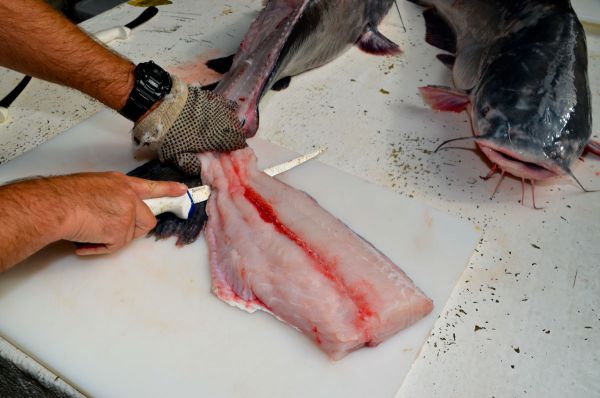 7) Turn the fillet over, trim off and discard any red meat except that along the center of the fillet.
7) Turn the fillet over, trim off and discard any red meat except that along the center of the fillet.
 8) Make a cut through the fillet along each side of the red strip at its center. Discard the red meat strip and set aside the two slabs of white meat.
8) Make a cut through the fillet along each side of the red strip at its center. Discard the red meat strip and set aside the two slabs of white meat.
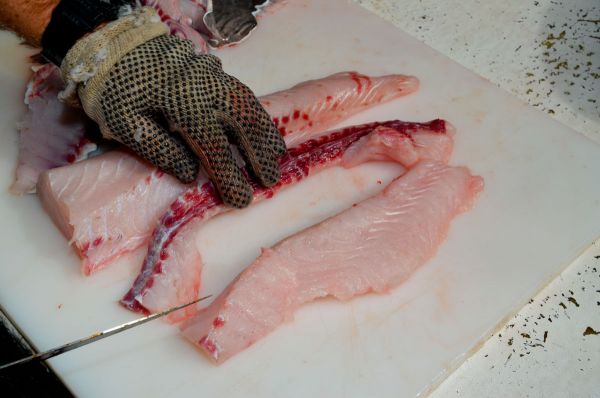 9) Returning to the fish, cut through the skin from the point behind the dorsal fin of the previous cuts forward until the knife hits the bone of the skull.
9) Returning to the fish, cut through the skin from the point behind the dorsal fin of the previous cuts forward until the knife hits the bone of the skull.
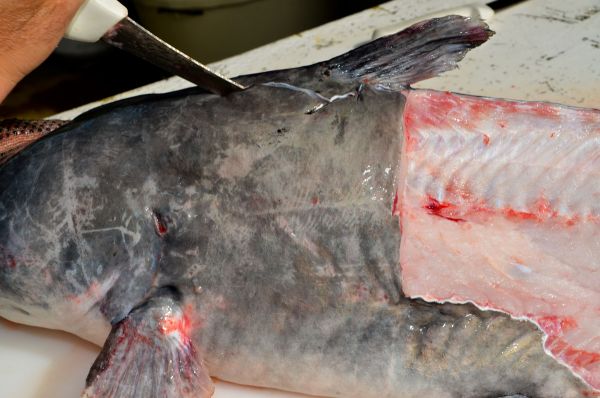 10) Cut the head nugget of flesh free from the backbone.
10) Cut the head nugget of flesh free from the backbone.
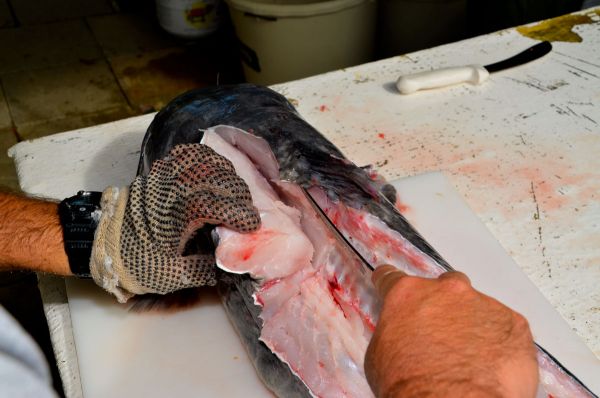 11) Cut the skin free from the head nugget and from the underlying rib cage.
11) Cut the skin free from the head nugget and from the underlying rib cage.
 12) Each side of the fish will produce three cuts of boneless, white meat, a head nugget, an upper fillet and a lower fillet.
12) Each side of the fish will produce three cuts of boneless, white meat, a head nugget, an upper fillet and a lower fillet.

